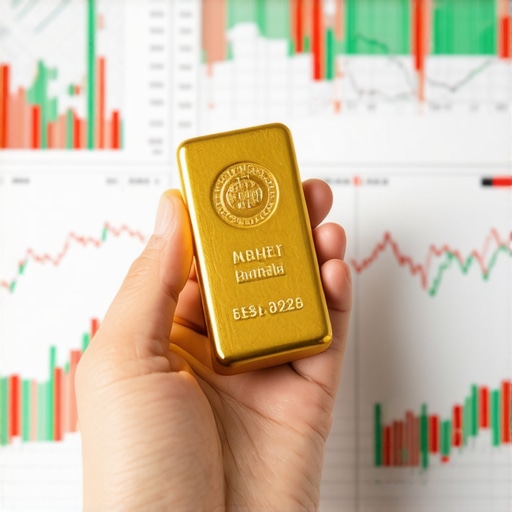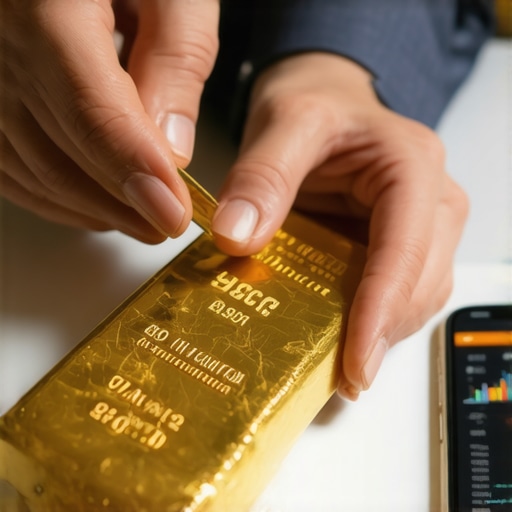Understanding the Importance of Gold Investment
Investing in gold is a time-honored strategy that has stood the test of time, providing stability and growth opportunities for investors. With the rising uncertainties in the global economy, many are turning to gold as a safe haven asset. This guide will explore how to invest in gold successfully, equipping you with expert tips and insights to navigate the complexities of the gold market.
Why Invest in Gold?
Gold has been recognized as a valuable asset for centuries, serving not only as a medium of exchange but also as a store of value. Its intrinsic value makes it a reliable investment during periods of economic downturns. Additionally, gold can offer diversification benefits within a portfolio, as it often behaves differently from traditional stocks and bonds. Understanding the importance of gold for hedging against inflation is crucial for any investor looking to safeguard their wealth.
Types of Gold Investments
When considering how to invest in gold, it’s essential to understand the various forms in which gold is available. Here are the primary types of gold investments:
- Physical Gold: This includes gold coins, bars, and bullion. Investing in physical gold allows you to possess a tangible asset, which can be stored securely.
- Gold ETFs: Exchange-Traded Funds (ETFs) are a popular choice for investors seeking exposure to gold without holding the physical asset. They track the price of gold and can be bought and sold like stocks.
- Gold Mining Stocks: Investing in companies that mine gold can offer leveraged exposure to gold prices. However, they also come with additional risks related to operational performance.
- Gold Mutual Funds: These funds pool money from multiple investors to invest in gold-related assets, including mining stocks and physical gold, providing diversification.
Choosing the right investment type depends on your financial goals, risk tolerance, and investment strategy.
Key Tips for Successful Gold Investment
To ensure a successful investment in gold, consider the following expert tips:
- Research the Market: Stay informed about the latest trends and factors that influence gold prices. Understanding the global factors influencing gold demand can help you make informed decisions.
- Start Small: If you’re new to gold investing, consider starting with a small amount. This approach allows you to learn the market dynamics without taking on excessive risk.
- Diversify Your Portfolio: Don’t put all your eggs in one basket. Diversifying your investments can mitigate risks and enhance potential returns.
- Consult Experts: Seeking advice from financial advisors or experts in gold investment can provide valuable insights and strategies tailored to your needs.
By following these guidelines and understanding the nuances of the gold market, you can position yourself for success in your gold investment journey. For further detailed strategies, check out our post on maximizing your gold ETF portfolio.
Understanding Gold Market Trends
To effectively invest in gold, it’s vital to grasp the current market trends and their implications. The gold market is influenced by various factors, including economic indicators, geopolitical events, and changes in investor sentiment. By staying updated on global demand trends, you can better anticipate price movements and make informed investment decisions.
Analyzing Economic Indicators
Economic indicators play a critical role in shaping the gold market. Key metrics such as inflation rates, interest rates, and currency values can significantly impact gold prices. For instance, when inflation rises, gold is often seen as a hedge, driving demand up. Understanding these indicators is essential for any investor aiming to build a robust gold portfolio.
Interest Rates and Gold Prices
Interest rates have a direct correlation with gold prices. Typically, lower interest rates lead to higher gold prices, as investors seek alternatives to low-yielding bonds or savings accounts. Conversely, rising interest rates can diminish gold’s appeal. Therefore, closely monitoring interest rate trends is crucial for predicting gold price fluctuations.
Geopolitical Factors Impacting Gold Demand
Geopolitical tensions often lead to increased gold demand as investors flock to safe-haven assets. Events such as conflicts, trade wars, and political instability can drive gold prices higher. Being aware of these factors can provide insights into potential investment opportunities. For instance, during times of uncertainty, gold often serves as a reliable asset for preserving wealth.
Diversifying Your Gold Investments
Diversification is a key strategy in any investment portfolio, including gold. By spreading your investments across different types of gold assets, you can mitigate risks and enhance returns. Consider allocating your portfolio among physical gold, gold ETFs, and mining stocks. This approach allows you to benefit from various market conditions and reduces the impact of any single asset’s poor performance.
Investing in Gold Mining Stocks
Gold mining stocks can be an attractive option for investors looking to leverage the price of gold. These stocks typically offer greater potential returns compared to physical gold, but they also come with increased risk related to operational performance. Understanding the risks associated with gold mining stocks is essential before diving in.
Utilizing Gold ETFs for Portfolio Growth
Gold ETFs provide an excellent way to gain exposure to gold without the need to physically hold the asset. They are designed to track the price of gold and can be bought and sold like regular stocks. For those interested in maximizing returns, exploring the options for gold ETFs in 2025 may yield profitable opportunities.
Conclusion: Building a Gold Investment Strategy
In conclusion, investing in gold requires a thorough understanding of market dynamics, economic indicators, and diversification strategies. By staying informed and adapting your approach to changing conditions, you can position yourself for success in the gold market. Whether you choose physical gold, ETFs, or mining stocks, always consider your financial goals and risk tolerance to craft an effective investment strategy.
Understanding the Role of Gold in Economic Uncertainty
Gold has historically been viewed as a safe-haven asset during times of economic turmoil. Understanding how gold performs in these scenarios is crucial for investors. During financial crises, gold often retains or increases its value, providing a hedge against inflation and currency devaluation. This characteristic makes it an essential component of a diversified investment portfolio, especially in unpredictable markets.
Gold as a Hedge Against Inflation
Investing in gold can serve as a reliable hedge against inflation. As the purchasing power of currency declines, the value of gold tends to rise. This inverse relationship between gold and inflation makes it a strategic asset for preserving wealth. Therefore, closely monitoring inflation trends can guide your investment decisions, ensuring your portfolio remains resilient.
Evaluating Gold Investment Types
When investing in gold, it’s important to understand the various types of investments available. Each type has its unique advantages and risks, and a well-rounded approach can lead to greater overall returns. Consider exploring different investment avenues such as physical gold, ETFs, mutual funds, and mining stocks.
Physical Gold vs. Gold ETFs
Investors often debate whether to invest in physical gold or gold ETFs. Physical gold, such as coins and bars, provides tangible value, while ETFs offer liquidity and ease of trading. Understanding the pros and cons of each option is crucial for making informed decisions based on your investment goals.
Identifying Key Gold Market Trends
Staying informed about current market trends can help you make profitable investment choices. Key indicators, such as changes in demand, supply chain disruptions, and technological advancements in mining, can influence gold prices significantly. For instance, understanding the impact of global demand can provide insights into future price movements.
The Impact of Geopolitical Events on Gold Prices
Geopolitical events, such as conflicts and trade disputes, can cause spikes in gold prices as investors seek refuge from market volatility. Keeping an eye on global affairs allows you to anticipate potential shifts in gold demand. Historical data shows that during significant geopolitical tensions, the price of gold tends to rise, reinforcing its status as a reliable asset.
Maximizing Returns Through Strategic Diversification
Diversification is key to optimizing your gold investment strategy. By allocating resources among different types of gold assets, you can mitigate risks and enhance returns. For example, combining physical gold investments with gold mining stocks and ETFs can create a balanced portfolio that performs well in varying market conditions.
Investing in Gold Mining Stocks for Higher Returns
Gold mining stocks can offer higher returns than physical gold due to their operational leverage. However, they also come with increased risks, including operational challenges and market fluctuations. Understanding the risks associated with mining stocks is essential for making informed investment decisions.
Conclusion: Crafting Your Gold Investment Strategy for 2025
In summary, formulating an effective gold investment strategy involves understanding various market dynamics, evaluating different investment types, and continuously monitoring economic and geopolitical indicators. By leveraging these insights and diversifying your portfolio, you can position yourself for success in the gold market for 2025 and beyond.
Understanding Gold’s Volatility and Market Influences
Gold prices are subject to various influences, including economic data releases, interest rates, and investor sentiment. Staying attuned to these factors can enhance your investment strategy. For instance, changes in central bank policies can significantly impact gold prices, as lower interest rates often lead to increased gold purchases. Therefore, analyzing interest rates and their correlation with gold can provide insights into potential price movements.
The Relationship Between Gold and U.S. Dollar Strength
The strength of the U.S. dollar plays a crucial role in determining gold prices. A stronger dollar typically makes gold more expensive for foreign investors, leading to decreased demand. Understanding the dynamics of the dollar can aid in predicting gold price fluctuations and making timely investment decisions.
Long-Term vs. Short-Term Gold Investments
When considering gold investments, it’s essential to differentiate between long-term and short-term strategies. Long-term investments in gold tend to focus on wealth preservation, while short-term strategies might involve trading based on market fluctuations. Understanding your investment goals will guide your approach, whether you choose to hold physical gold or engage in gold trading strategies.
Trading Gold: Techniques for Success
For those interested in short-term investments, trading gold through options and futures can be lucrative. Familiarizing yourself with different trading techniques, such as technical analysis and trend analysis, is crucial. These methods can help identify entry and exit points, maximizing potential returns.
Emerging Trends in Gold Investment for 2025
As we approach 2025, several emerging trends are shaping the gold investment landscape. The rise of digital gold platforms and cryptocurrency-backed gold investments is gaining traction. These innovations offer new avenues for investors, making gold more accessible and easier to trade. Exploring digital gold options can be an exciting addition to your investment portfolio.
Environmental and Ethical Considerations in Gold Mining
As awareness of environmental issues grows, ethical considerations in gold mining are becoming increasingly important. Investors are now more inclined to support sustainable mining practices. Researching sustainable gold investments can help align your portfolio with ethical standards, potentially enhancing its attractiveness to socially conscious investors.
Conclusion: Preparing for a Dynamic Gold Investment Landscape
In conclusion, positioning yourself effectively in the evolving gold market requires a multifaceted approach. By understanding market dynamics, exploring various investment types, and keeping abreast of emerging trends, you can craft a robust gold investment strategy for 2025. Embrace the opportunities that lie ahead and navigate the complexities of the gold market with confidence.
Frequently Asked Questions About Gold Investments
1. What factors influence gold prices?
Gold prices are influenced by several key factors including inflation rates, interest rates, geopolitical stability, and the strength of the U.S. dollar. Investors should monitor these variables to understand potential price movements.
2. Is investing in gold a safe option?
While gold is often considered a safe haven during economic uncertainty, it is not without risks. Prices can be volatile, and investors should assess their risk tolerance and investment goals before diving in.
3. How do I start investing in gold?
To start investing in gold, consider your investment strategy. You can buy physical gold, invest in gold ETFs, or trade futures and options. Researching the different methods will help you choose the best approach for your financial goals.
4. What is the difference between physical gold and gold ETFs?
Physical gold refers to tangible items like coins and bars, while gold ETFs are securities that track the price of gold. Gold ETFs offer liquidity and ease of trading, whereas physical gold requires storage and insurance considerations.
5. How often should I review my gold investment portfolio?
It is advisable to review your gold investment portfolio at least annually or whenever there are significant market changes. Regular assessments allow you to align your investments with your financial goals and market conditions.
6. Are there tax implications for gold investments?
Yes, gold investments may be subject to capital gains tax when sold for a profit. It’s important to consult with a tax professional to understand your obligations based on your investment strategy.
7. What are the benefits of investing in gold for retirement?
Investing in gold for retirement can provide diversification, protect against inflation, and serve as a hedge during market downturns. Including gold in your retirement portfolio can enhance overall stability.
8. How do geopolitical events affect gold prices?
Geopolitical events often lead to increased uncertainty, which typically drives demand for gold as a safe-haven asset. Investors should stay informed about global events that could impact market stability.
9. Can I invest in gold through my retirement account?
Yes, certain retirement accounts such as IRAs allow for gold investments. However, there are specific regulations and requirements that must be met, so consulting a financial advisor is recommended.
10. What are the emerging trends in gold investment for the future?
Emerging trends include the rise of digital gold platforms, cryptocurrency-backed gold investments, and a growing focus on sustainable mining practices. Staying informed about these trends can help investors identify new opportunities.
Authority Resources for Gold Investment Insights
To further enhance your knowledge and understanding of gold investments, consider exploring the following trusted resources:
- World Gold Council – An authoritative source for gold market research and insights.
- Investopedia – A comprehensive resource for financial education, including articles on gold investing.
- Kitco – A leading precious metals retailer providing market news, data, and investment options.
- Bloomberg Markets – Offers real-time data and analysis of commodities, including gold.
- CNBC Gold – Provides the latest news and expert analysis on gold trends.
Conclusion: Embrace the Future of Gold Investment
In summary, navigating the complexities of gold investments in 2025 and beyond requires not only an understanding of market dynamics but also an appreciation of emerging trends and ethical considerations. By leveraging the insights provided in this article and utilizing the resources mentioned, you can develop a comprehensive strategy that aligns with your investment goals. Whether you’re inclined toward physical gold or innovative digital options, the future of gold investment holds numerous opportunities for savvy investors. Stay informed, be proactive, and position yourself to capitalize on the evolving landscape of gold investment.










